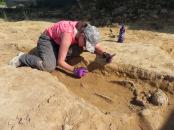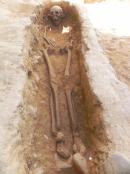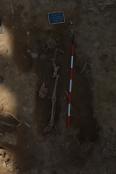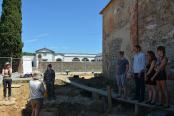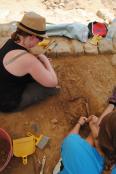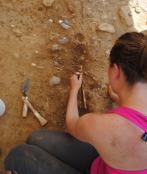CAMPAGNA 2015 |
1° SETTIMANA |
2° SETTIMANA |
3° SETTIMANA |
4° SETTIMANA |
5° SETTIMANA |
6° SETTIMANA |
07 LUGLIO 2015 
Resoconto della giornata di scavo
Area 2000
Nel Settore B iniziano ad emergere le evidenze relative alla fase medievale del cimitero. Tra i diversi tagli sepolcrali che sono stati individuati, tra cui il taglio US-2592 all’interno del quale è stata documentato USk 2595 (si preservano malamente la mandibola e parzialmente gli omeri distesi e paralleli), molto interessante risulta quello collocato nella metà meridionale e orientato canonicamente Est Ovest (US -2587); esso presenta una forma molto regolare ellissoidale ed è perfettamente allineato alla trincea centrale US -2581. All’interno è stato completamente messo in luce e documentato USk 2594 il quale, a differenza degli altri individuati sia a ridosso dell’abside, sia nel resto dell’area 1000 che nel Settore B dell’Area 2000, si è conservato ottimamente. Il cranio appare in norma superiore con una lieve dislocazione della mandibola, l’arto superiore destro è leggermente flesso sul pube, l’arto superiore sinistro disteso con la mano sul bacino, gli arti inferiori distesi paralleli con le ginocchia molto ravvicinate. Quest’ultimo aspetto, così come la lieve lassità di alcune articolazioni, fa pensare alla presenza di una veste o di un sudario; la decomposizione risulta pertanto in spazio parzialmente vuoto e il riempimento differito nel tempo. Un secondo scheletro in connessione anatomica, non in buono stato di conservazione è Usk 2598 deposto nella fossa sepolcrale US-2597 collocata all’interno della trincea centrale; anche in questo caso l’orientamento è Est Ovest e nella giornata di domani sarà terminata la messa in luce con conseguente documentazione. Nell’allargamento Ovest prosegue la messa in luce di Usk 2577 che sembra probabilmente completo.
Our group began by continuing to excavate the burials from yesterday. Usk 2577, in the western expansion, was found with articulated lower limbs, and an articulated right hand. Nails were discovered all around the skeleton, indicating it was buried in a coffin. In addition, a cross shaped pendant was found located on the right tibia. We are interpreting that a reduction area was located above the coffin and when the coffin decomposed the scattered bones collapsed on top of the skeletal remains. Usk 2595 was composed of a humerus and mandible and had 24 teeth in association. There were two medieval skeletons located in sector B as of yet, Usk 2594 and 2598. We continued to excavate Usk 2594 which was in good condition for its time period and exposed in full. It was properly photographed, and had GIS points taken. Usk 2598 consisted of a collapsed skull, two humeri, and both femora, the skull facing the church. Usk 2598 was located in the trench, and appeared to cut it. Since its exposure is not yet completed, additional excavation will continue tomorrow, along with USk 2577, and the removal of USk 2594.
Area 3000
Nel corso della mattinata si è proceduto con la pulizia generale della porzione meridionale del Settore B, che ha permesso l’individuazione di alcuni tagli di fosse sepolcrali, con orientamenti diversi, che si intercettano vicendevolmente. In particolare, nella giornata di oggi è iniziata la rimozione del riempimento US 3422 all’interno del taglio US – 3421, che sta mettendo in luce il lato destro di un individuo in connessione anatomica, orientato S-N, la cui parte sinistra è stata tagliata da una canaletta di epoca moderna. Immediatamente ad est di US – 3421 è in corso lo scavo dello scheletro USK 3579, in cattivo stato di conservazione, la cui metà inferiore del corpo sembra essere stata asportata accidentalmente dai mezzi meccanici durante l’ampliamento dell’area avvenuta l’anno scorso. Lungo la sezione sud-occidentale della trincea US – 3486 continua inoltre l’indagine della fossa sepolcrale US – 3569, orientata W-E, che sarà approfondita nei giorni seguenti.
Today we began by cleaning the southern section of sector B, which we then sprayed down in order to see changes in the soil. After this, we then outlined possible areas to focus on. US 3422 was excavated. There was a portion of a cranium visible above the soil, however the grave was empty. The grave next to US 3422 was then started. A portion of a tibia and patella was visible above the soil. However, this grave is adjacent to a trench that connects to Area 5000. After beginning the excavation, only the right tibia, fibula, patella, femur and part of the pelvis remain of the individual. The rest of the remains were removed when the trench was built. A rosary bead was found near the individual, however it was not in context with the bones. In the burial directly next to the previously discussed burial, we found a partial skeleton with a torso and part of the pelvis, but missing the upper limbs and most of the lower limbs. This person was buried with a burial shroud as evidenced by the presence of a pin found near the chest. Also, we found many small beads in connection near the neck of this individual. Tomorrow we will continue to document and remove the skeleton from the grave. We continued the excavation of another grave which was particularly deep and uncovered partial sections of both an adult and infant cranium amongst additional scattered bones from both bodies. We will further uncover these bodies to gain more information on the burials and hopefully find more bones in connection. In the northern half of area 3000B we further identified the location of a firing pit. To the east of the identified pit we discovered many bronze slags and an articulated skeleton. Pictures and altitude data were taken for the fill. Excavation of the skeletal material identified today will be further explored in the following days.
Area 5000
Area 5000 spent the morning filling out stratigraphic contexts sheets and photographing the features that emerged the day before. The rest of the day was spent delineating four possible holes on the upmost layer of the western side. US 5191, the northernmost hole, was determined to be a deeper hole than originally thought and was a composed of hard dirt, brick and slate. US 5192 was surrounded and filled with red bricks and the bottom was identified. US 5193, meanwhile, was labelled a concentration of rock and brick upon further investigation. Finally, US 5194 proved to be a shallow hole filled with slate and one section that went deeper than the rest. GIS elevation points were taken in each of these features before the area was cleaned and dampened to better observe the delineations.
Area 6000
Con la giornata odierna è stato messo in luce il taglio US -6025, la buca circolare che taglia completamente la metà superiore dell'individuo USk 6023. Tale buca presentava come riempimento una grande quantità di pietre di medie dimensioni oltre che, sul fondo, un elemento litico di c.a. 35 cm di altezza. Si ipotizza che il piatto superiore di tale elemento, in associazione con la buca in cui era infisso, costituisse (in epoca pre-contemporanea, XIX sec.) la base d'appoggio di una palificazione lignea relativa alle fasi di vita dell'area. Nel settore A, dopo una attenta pulizia, sono state messe in evidenza diverse situazioni stratigrafiche tra cui US 6029 (nel quadrante sud-est, strato argilloso marrone scuro e fortemente compatto con all'interno numerosi frammenti ossei, segno di una precedente interazione con i livelli cimiteriali) ed US 6028 (riempimento di US -6027, taglio subrettangolare nell'angolo nord-ovest del settore, intercettato dalla trincea di drenaggio US -6007 e probabilmente riconducibile ad una sepoltura).
Our group worked on a few different areas of 6000 today. One of us worked within Area 6001 removing large rocks that weren’t part of burial Area 6021/6024 and exposing the cut of the new area created by removing those large rocks. That reduction was called Area 6025 and one of the rocks might have been a posthole where a pillar might have stood. In that area, lots of 19th century pottery and bone fragments were found, particularly near the skeleton. Photographs and GIS points were also taken. Tomorrow, we will take out the reduction of the 6021/6024 skeleton.
In Area 6003, a rectangular patch (Area 6029) orientated east to west contained different color, composition, and consistency than the rest of the area. The cut was defined and the patch was mostly taken out, which will be continued tomorrow. Similarly, another smaller rectangular patch (Area 6028) right next to the trench was cut out and removed to find the older layer.







